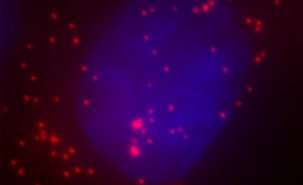Nobel Prize-winning discovery will better train scientists' eyes

Ever since mankind's first attempts to understand what we are made of, we have tried to see and study small things, things not visible to the naked eye. Using magnifying lenses, scientists quickly realized that we are composed of cells, and that cells are composed of even smaller parts. Today, much of our knowledge on how cells function is based on microscopic observations. Three scientists recently received the Nobel Prize in Chemistry for the development of microscopy approaches, allowing to observe molecules in cells in even more detail. Stefan Hell of Germany and Eric Betzig and William Moerner of the United States share the prize for "the development of super-resolved fluorescence microscopy."
Why does this matter to humanity? To Canadians? To me? In my laboratory at Université de Montréal, we use the latest generation of microscopes to detect single molecules to study how genetic information is read and interpreted in cells. We use simple organisms like yeast to set up experimental techniques and study basic concepts of cells, and then apply those techniques to study disease models. When our team first developed tools to detect individual molecules in yeast cells, it dramatically changed how previous data was interpreted, and now many scientists use such tools to study diseases. Combining those tools with the super-resolution techniques recognized by the Nobel committee will reveal many important insights into the causality of diseases.
Fluorescent light microscopy is an indispensable tool in biomedical research. It allows scientist to see molecules within cells and to study why they sometimes causes diseases. Up until now, light microscopy has been seriously limited by the physical properties of light. The microscopist Ernst Abbe first described the "diffraction limit" in 1873, which prevents separating molecules when they're closer than about 200 nanometers to each other. Unfortunately, most processes inside cells take place at length scales much shorter than this. It seemed like such unbreakable barrier that it was set in stone at the University of Jena's memorial to Abbe. However, the methods developed by the Nobel Prize Laureates overcome this hurdle and bring microscopy into the nano-dimension.
Science has always relied on observation. We leaned to build planes by observing birds. As researchers, we observe and postulate a hypothesis that we then test. This is part of the basic creative process in science. The second most important factor besides observation is technology. Many major breakthroughs in biomedical science are paralleled by the development of new technologies: new ways to detect small quantities of molecules, more diverse molecules, or new molecules. We depend on a constant development of new technologies to ensure we don't just move in small incremental step, but sometimes giant leaps too – big breakthroughs that radically change our understanding of life.
And so at the Department of Biochemistry and Molecular Medicine, where my lab is situated, we're particularly excited about this year's Nobel prizes, as they parallel the installation of two super-resolution microscopes, the first of their kind at our university. Financed through the Canada Foundation for Innovation and shared in part with the Faculty of Dentistry, these instruments will allow us to further push the boundaries of science, and connect molecular cell biology and structural biology, two of the main focus areas at the department. We'll be able to observe those 'small things' in unprecedented resolution, allowing us to study these beautifully complex processes that are the basis of life, and whose understanding is essential in order to find cures for the many diseases where cellular processes are impaired.
Provided by University of Montreal


















